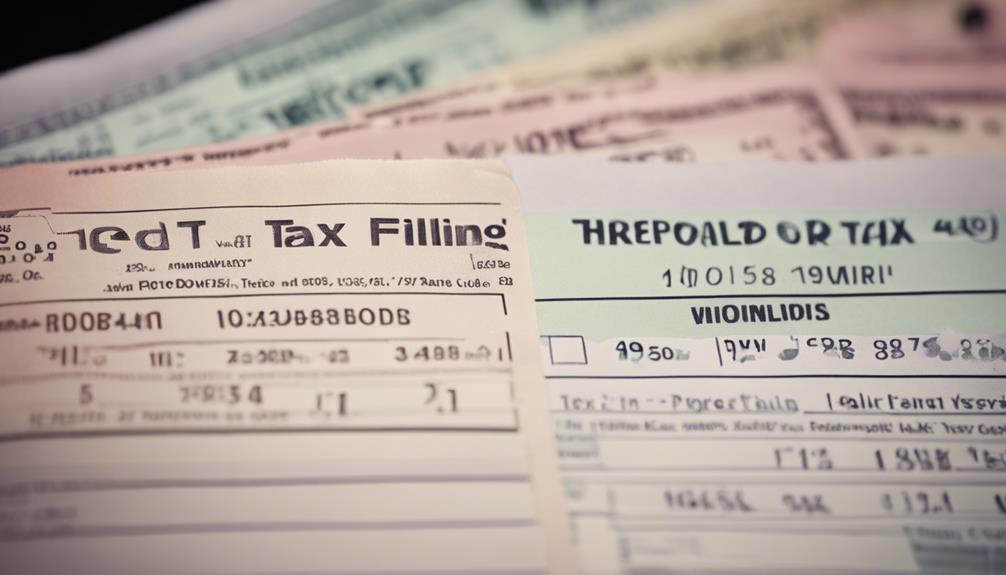In 2016, Federal Tax Rates for Married Filing Jointly varied from 10% to 39.6%, based on total income. It is crucial to be familiar with these rates in order to calculate tax responsibilities correctly. Knowing the brackets is key for tax planning and optimizing savings. Couples can take advantage of strategic changes and tax credits to reduce their overall tax burden significantly. To gain a better insight into how tax rates can influence your financial situation, delve deeper.
Key Takeaways
- 2016 tax rates for married filing jointly range from 10% to 39.6%.
- Different income brackets exist, with higher rates for higher incomes.
- Understanding tax rates aids in effective tax planning.
- Tax credits and deductions can reduce tax liability for couples.
- Awareness of brackets and rates informs investment and retirement decisions.
Overview of 2016 Federal Tax Rates
The overview of 2016 Federal Tax Rates for married couples filing jointly reveals a progressive tax system. Tax rates varied from 10% to 39.6%, dependent on income levels. For married filing jointly status, different income brackets were in place, with higher rates applying to higher incomes.
The top tax rate of 39.6% was for taxable income exceeding $466,950. Understanding these tax rates is essential for effective tax planning and preparation. Married couples filing jointly could benefit from utilizing tax credits and deductions to reduce their overall tax liability.
By comprehending the federal tax rates applicable in 2016, couples could strategically plan their finances to optimize tax savings. Being aware of the various tax brackets and rates aids in making informed decisions regarding investments, retirement planning, and other financial aspects.
It's advisable for couples to explore all available avenues for tax relief to maximize savings and ensure compliance with federal tax regulations.
Understanding Married Filing Jointly Tax Brackets

Married couples filing jointly benefit from tax rates ranging from 10% on income up to $19,900 to 37% on income over $647,850 for tax year 2023. Understanding these tax brackets and rates is important for effective tax planning. The thresholds for married filing jointly status are set higher than those for individual filers, offering the potential for tax savings. Couples need to take into account their taxable income and make adjustments to maximize their tax benefits under the federal income tax system.
By knowing the brackets and rates, couples can strategically plan to minimize their tax liability. As tax laws evolve, adjustments to the brackets and rates are made annually to account for inflation and other changes. Being aware of these adjustments is necessary for accurate tax planning. Married couples filing jointly also have access to specific deductions and benefits that can further reduce their overall tax burden.
Therefore, understanding the nuances of tax brackets and rates for married filing jointly status is key in optimizing tax savings and financial planning.
Calculating Tax Liability for Couples

When calculating tax liability for couples, considering combined income levels is essential for determining the applicable tax rate brackets.
Understanding how tax rates work for married filing jointly status can lead to lower tax rates and optimize tax savings.
Here are three key points to keep in mind when calculating tax liability for couples:
- Tax rates for married couples are based on their combined income, which may result in a different tax bracket compared to when filing as single individuals.
- Tax liability is determined by the total income of both spouses, influencing the federal income tax brackets that apply to the couple.
- Married filing jointly status can offer opportunities for tax savings through strategic planning and utilizing the lower tax rates available for combined incomes.
Planning Finances Based on Tax Rates

Understanding how tax rates for married couples are structured based on combined income levels is essential for effective financial planning. When considering tax rates for married filing jointly, it's important to grasp the concept of tax brackets and income thresholds.
By comprehending these elements, couples can strategically plan their finances to optimize tax savings. Married couples filing jointly often benefit from lower tax rates compared to individual filers, allowing them to potentially reduce their taxable income and take advantage of various tax credits and deductions.
Effective tax planning involves analyzing the combined income of both spouses to determine the most advantageous way to file taxes. By utilizing tax brackets effectively and exploring available deductions and credits, couples can minimize their tax liabilities and maximize savings.
Tips for Maximizing Tax Savings

To maximize tax savings, individuals can strategically utilize various deductions and credits available to them. Consider the following tips for maximizing savings:
- Utilize deductions:
Take advantage of deductions such as mortgage interest, charitable contributions, and medical expenses to reduce taxable income.
- Contribute to retirement accounts:
Consider contributing to retirement accounts like 401(k) or IRA to lower taxable income and save for the future simultaneously.
- Explore tax credits:
Look into tax credits like the Child Tax Credit or Earned Income Tax Credit to further reduce your tax liability and maximize savings.
It is essential to review potential tax breaks for education expenses, student loan interest, and childcare costs. Consulting with a tax professional can also provide valuable insights into maximizing tax savings and making informed financial decisions.
Frequently Asked Questions
How Much Is Federal Tax for Married Filing Jointly?
The federal tax for married filing jointly varies based on income levels, ranging from 10% to 37%. Understanding tax brackets and deductions is essential for couples to plan effectively and manage their tax liabilities.
How Much Federal Tax Is Withheld for Married Filing Jointly?
When married filing jointly, federal tax withholding varies based on income levels and tax credits. Couples can adjust their withholding using IRS Form W-4 to align with their tax liability and take advantage of deductions.
What Is the Standard Federal Tax Deduction for Married Filing Joint?
When married couples file jointly, they can benefit from the standard deduction, an amount set at $25,900 for tax year 2023. This deduction reduces taxable income, potentially lowering their overall tax liability.
What Is the Tax Rate for a Married Filing Jointly Making $200 000?
When a married couple filing jointly has an income of $200,000, their tax rate for 2023 ranges from 10% to 24%. Understanding these tax brackets helps in making informed decisions for accurate tax planning.
Conclusion
To sum up, the 2016 federal tax rates for married filing jointly can have a significant impact on couples' finances.
One interesting statistic to note is that the top tax rate for this filing status was 39.6%, affecting households with higher incomes.
It's important for couples to understand their tax brackets and plan their finances accordingly to maximize tax savings.
By staying informed and proactive, couples can navigate the tax system effectively.










